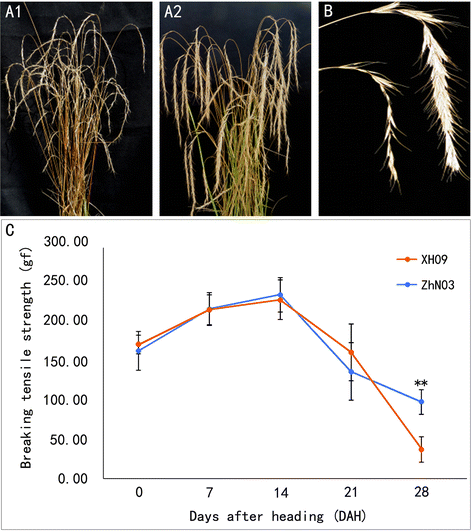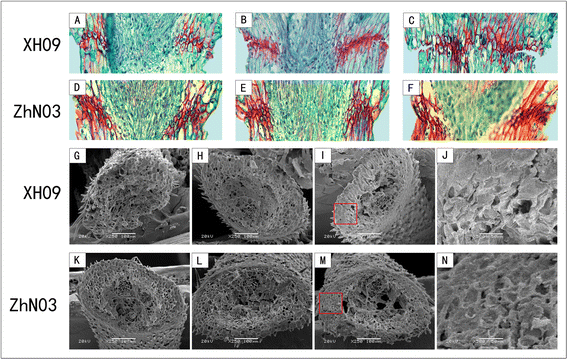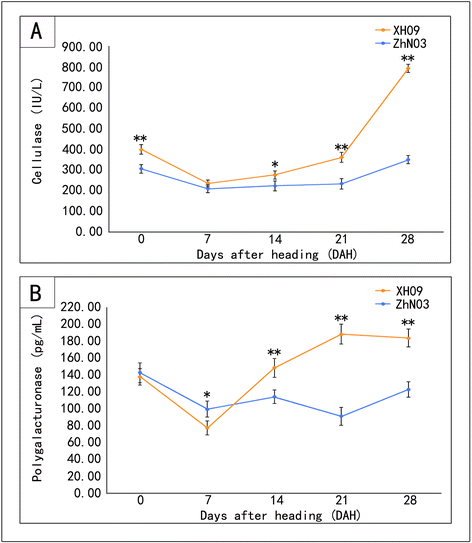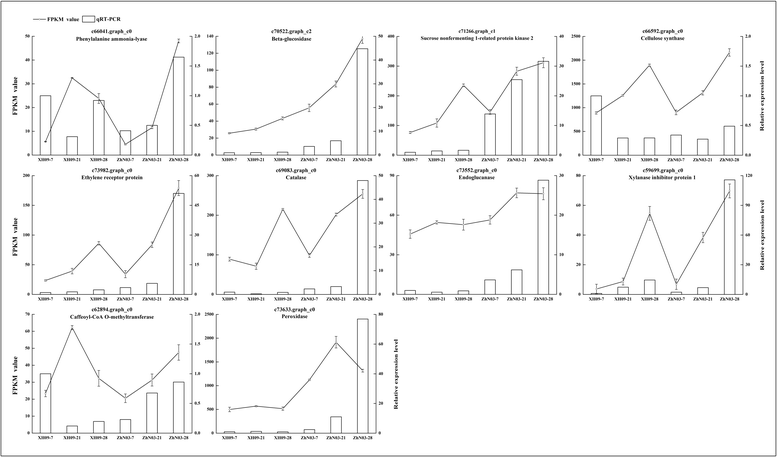Transcriptome profiling of Elymus sibiricus, an important forage grass in Qinghai-Tibet plateau, reveals novel insights into candidate genes that potentially connected to seed shattering
- PMID: 28431567
- PMCID: PMC5399857
- DOI: 10.1186/s12870-017-1026-2
Transcriptome profiling of Elymus sibiricus, an important forage grass in Qinghai-Tibet plateau, reveals novel insights into candidate genes that potentially connected to seed shattering
Abstract
Background: Elymus sibiricus is an important forage grass in semi-arid regions, but it is difficult to grow for commercial seed production due to high seed shattering. To better understand the underlying mechanism and explore the putative genes related to seed shattering, we conducted a combination of morphological, histological, physiochemical and transcriptome analysis on two E. sibiricus genotypes (XH09 and ZhN03) that have contrasting seed shattering.
Results: The results show that seed shattering is generally caused by a degradation of the abscission layer. Early degradation of abscission layers was associated with the increased seed shattering in high seed shattering genotype XH09. Two cell wall degrading enzymes, cellulase (CE) and polygalacturonase (PG), had different activity in the abscission zone, indicating their roles in differentiation of abscission layer. cDNA libraries from abscission zone tissue of XH09 and ZhN03 at 7 days, 21 days and 28 days after heading were constructed and sequenced. A total of 86,634 unigenes were annotated and 7110 differentially expressed transcripts (DETs) were predicted from "XH09-7 vs ZhN03-7", "XH09-21 vs ZhN03-21" and "XH09-28 vs ZhN03-28", corresponding to 2058 up-regulated and 5052 down-regulated unigenes. The expression profiles of 10 candidate transcripts involved in cell wall-degrading enzymes, lignin biosynthesis and phytohormone activity were validated using quantitative real-time PCR (qRT-PCR), 8 of which were up-regulated in low seed shattering genotype ZhN03, suggesting these genes may be associated with reduction of seed shattering.
Conclusions: The expression data generated in this study provides an important resource for future molecular biological research in E. sibiricus.
Keywords: Abscission layers; Elymus sibiricus; Mechanism; Next-generation sequencing; Seed shattering; Transcriptome analysis.
Figures





Similar articles
-
Elymus nutans genes for seed shattering and candidate gene-derived EST-SSR markers for germplasm evaluation.BMC Plant Biol. 2019 Mar 13;19(1):102. doi: 10.1186/s12870-019-1691-4. BMC Plant Biol. 2019. PMID: 30866819 Free PMC article.
-
Construction of the first high-density genetic linkage map and identification of seed yield-related QTLs and candidate genes in Elymus sibiricus, an important forage grass in Qinghai-Tibet Plateau.BMC Genomics. 2019 Nov 14;20(1):861. doi: 10.1186/s12864-019-6254-4. BMC Genomics. 2019. PMID: 31726988 Free PMC article.
-
Histological Characteristics, Cell Wall Hydrolytic Enzymes Activity and Candidate Genes Expression Associated with Seed Shattering of Elymus sibiricus Accessions.Front Plant Sci. 2017 Apr 19;8:606. doi: 10.3389/fpls.2017.00606. eCollection 2017. Front Plant Sci. 2017. PMID: 28469634 Free PMC article.
-
Advances in Rice Seed Shattering.Int J Mol Sci. 2023 May 17;24(10):8889. doi: 10.3390/ijms24108889. Int J Mol Sci. 2023. PMID: 37240235 Free PMC article. Review.
-
Seed shattering: from models to crops.Front Plant Sci. 2015 Jun 24;6:476. doi: 10.3389/fpls.2015.00476. eCollection 2015. Front Plant Sci. 2015. PMID: 26157453 Free PMC article. Review.
Cited by
-
Potential Effects of Awn Length Variation on Seed Yield and Components, Seed Dispersal and Germination Performance in Siberian Wildrye (Elymus sibiricus L.).Plants (Basel). 2019 Dec 1;8(12):561. doi: 10.3390/plants8120561. Plants (Basel). 2019. PMID: 31805733 Free PMC article.
-
Molecular karyotyping of Siberian wild rye (Elymus sibiricus L.) with oligonucleotide fluorescence in situ hybridization (FISH) probes.PLoS One. 2020 Jan 17;15(1):e0227208. doi: 10.1371/journal.pone.0227208. eCollection 2020. PLoS One. 2020. PMID: 31951623 Free PMC article.
-
Endodermal apoplastic barriers are linked to osmotic tolerance in meso-xerophytic grass Elymus sibiricus.Front Plant Sci. 2022 Sep 23;13:1007494. doi: 10.3389/fpls.2022.1007494. eCollection 2022. Front Plant Sci. 2022. PMID: 36212320 Free PMC article.
-
Elymus nutans genes for seed shattering and candidate gene-derived EST-SSR markers for germplasm evaluation.BMC Plant Biol. 2019 Mar 13;19(1):102. doi: 10.1186/s12870-019-1691-4. BMC Plant Biol. 2019. PMID: 30866819 Free PMC article.
-
Selection of Suitable Reference Genes for RT-qPCR Gene Expression Analysis in Siberian Wild Rye (Elymus sibiricus) under Different Experimental Conditions.Genes (Basel). 2019 Jun 13;10(6):451. doi: 10.3390/genes10060451. Genes (Basel). 2019. PMID: 31200580 Free PMC article.
References
-
- Dong Y, Wang YZ. Seed shattering: from models to crops. Front Plant Sci. 2015;6:476. Available from: https://www.ncbi.nlm.nih.gov/pubmed/2615745. Accessed 7 May 2016. - PMC - PubMed
-
- Konishi S, Izawa T, Lin SY, Ebana K, Fukuta Y, Sasaki T, Yano M. An SNP caused loss of seed shattering during rice domestication. Science. 2006;312:1392–1396. Available from: https://www.ncbi.nlm.nih.gov/pubmed/16614172. Accessed 7 May 2016. - PubMed
-
- Patterson SE. Cutting loose. Abscission and dehiscence in Arabidopsis. Plant Physiol. 2001;126:494–500. Available from: https://www.ncbi.nlm.nih.gov/pubmed/11402180. Accessed 7 May 2016. - PMC - PubMed
-
- Elgersma A, Leeuwangh JE, Wilms HJ. Abscission and seed shattering in perennial ryegrass (Lolium perenne L.). Euphytica. 1988;39:51–57. Available from: https://link.springer.com/article/10.1007%2FBF00043367. Accessed 7 May 2016. - DOI
-
- Thurber CS, Hepler PK, Caicedo AL. Timing is everything: early degradation of abscission layer is associated with increased seed shattering in U.S. weedy rice. BMC Plant Biol. 2011;11:1–10. Available from: https://www.ncbi.nlm.nih.gov/pubmed/21235796. Accessed 7 May 2016. - PMC - PubMed
Publication types
MeSH terms
Substances
LinkOut - more resources
Full Text Sources
Other Literature Sources

